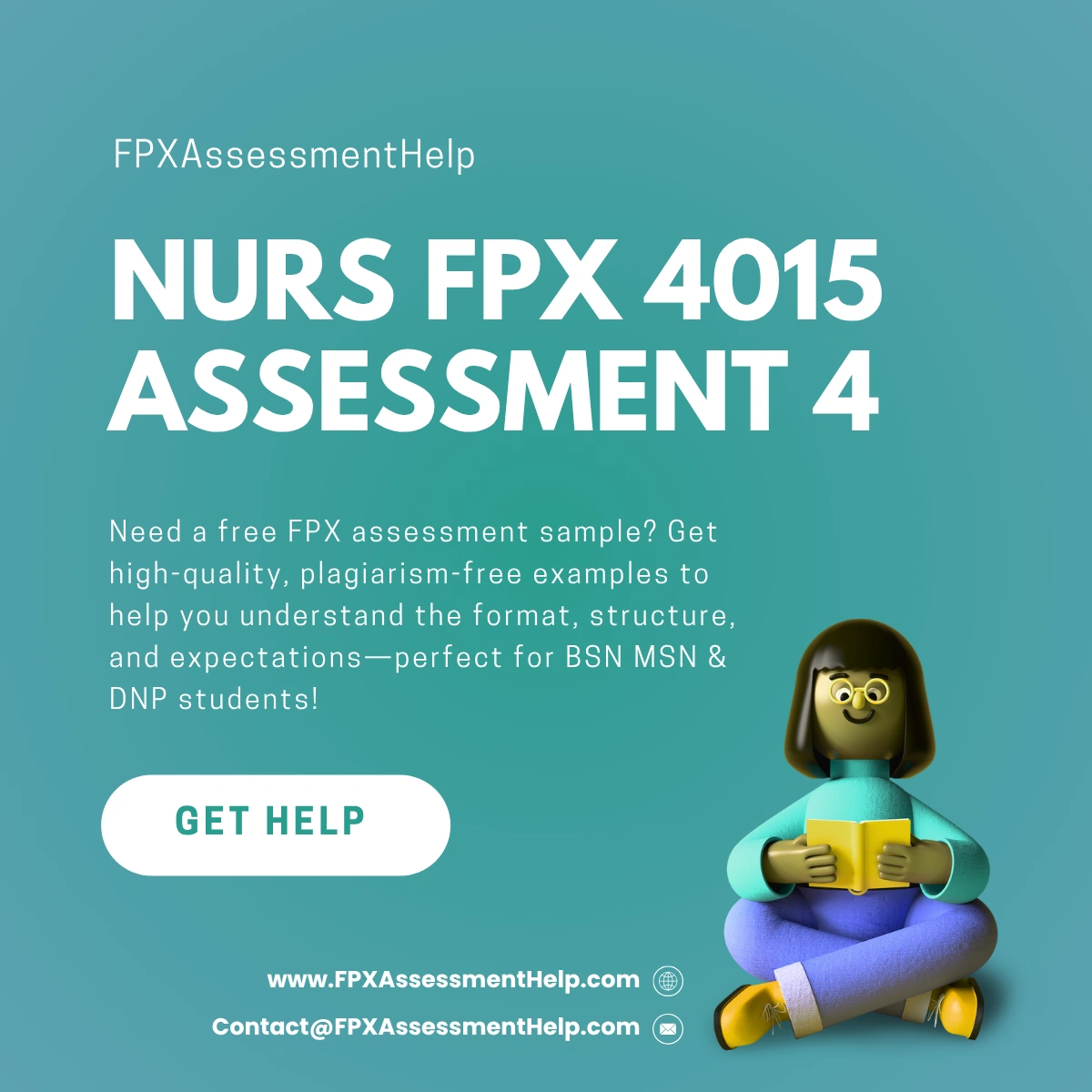NURS FPX 4015 Assessment 4 Caring for Special Populations Teaching Presentation
Student Name
Capella University
NURS-FPX4015 Pathophysiology, Pharmacology, and Physical Assessment: A Holistic Approach to Patient-Centered Care
Prof. Name
Date
Caring for Special Populations: Teaching Presentation
Introduction to the Special Population Group
Disabled veterans form a distinctive segment of the population with complex healthcare needs rooted in their military service. These individuals may experience physical injuries, traumatic brain injuries (TBI), and psychological conditions such as post-traumatic stress disorder (PTSD). Challenges extend beyond health to include difficulty with employment, daily living, transportation, and housing. According to Vespa and Carter (2024), out of 16.2 million U.S. veterans in 2022, about 5.4 million were compensated for service-connected disabilities, with over \$112 billion spent on these benefits.
Veterans with disabilities often encounter barriers when navigating healthcare systems. Many delay care due to lack of transportation, absence of caregivers, or issues securing appointments through the Veterans Affairs (VA) system. Chronic pain, mobility limitations, and co-occurring conditions such as heart disease, diabetes, and substance use disorders are common (Kane, 2023). Mental health challenges are particularly concerning, with high rates of depression and PTSD frequently going undiagnosed or untreated, which leads to social isolation and diminished quality of life (Gray et al., 2024).
Improving health outcomes requires a strategy grounded in the Social Determinants of Health (SDOH), including stable housing, financial support, transportation, and accessible healthcare. Community-based care models combined with veteran-specific services, such as VA housing programs, mobile health units, and peer counseling, are essential. Trauma-informed nursing, cultural competence, and simplified access to benefits are all vital components in reducing disparities and improving care continuity (Kane, 2023).
Cultural Values and Beliefs Relevant to Healthcare
Culturally responsive care for disabled veterans involves understanding their military background, trauma history, and the social and physical challenges they face. Many carry visible and invisible injuries that affect mobility, cognition, and emotional regulation. Veterans often exhibit hesitancy toward healthcare providers due to prior negative encounters, perceived stigma, or bureaucratic inefficiencies in the VA system (Chargualaf et al., 2021).
Nurses can bridge this gap by adopting trauma-informed practices that build trust and foster open communication. Culturally competent training helps nurses recognize military customs, mental health triggers, and common service-related issues, facilitating more effective care relationships. Regular interaction, empathy, and patient-centered communication are essential strategies for addressing treatment hesitancy (Chargualaf et al., 2021).
Further, many veterans struggle with accessing or affording medications and services. Nurses play an advocacy role by connecting them to case managers, housing programs, and mental health services. Integration of SDOH and interdisciplinary partnerships improves health equity and outcomes, particularly for underserved subgroups like women, LGBTQ+, and rural veterans.
Table 1: Key Cultural and Social Considerations for Disabled Veterans
| Category | Cultural/Social Relevance | Nursing Implications |
|---|---|---|
| Military Culture | Emphasis on discipline, hierarchy, and stoicism | Use respectful communication, understand chain-of-command |
| Mental Health Stigma | Hesitancy to disclose psychological issues | Provide non-judgmental, trauma-informed support |
| System Navigation Barriers | Complexity in VA and civilian systems | Offer care coordination and advocacy |
| Trust and Engagement | Mistrust due to previous negative healthcare experiences | Build rapport through empathy and reliability |
Healthcare Disparities Faced by Disabled Veterans
Disabled veterans face substantial disparities due to physical impairments, psychiatric disorders, and fragmented healthcare systems. Delays in care are common and often result in exacerbated conditions, higher emergency service utilization, and elevated suicide risk among this group. Limited access to mental health screenings, rehabilitation services, and preventive care exacerbates existing health challenges (Kane, 2023).
Demographically, the disabled veteran population is diverse. Some have visible disabilities, while others live with less apparent conditions such as PTSD or TBI. Specific subgroups face unique challenges. For instance, women veterans may experience chronic pain that is underdiagnosed, while LGBTQ+ veterans sometimes avoid care due to discrimination. Rural veterans also suffer disproportionately from limited access to specialty care due to geographic isolation (Carey et al., 2022).
Table 2: Disparities Among Disabled Veteran Subgroups
| Subgroup | Key Challenges |
|---|---|
| Women Veterans | Gender-specific care gaps, chronic pain underdiagnosis |
| LGBTQ+ Veterans | Discrimination, reluctance to seek VA services |
| Rural Veterans | Geographic isolation, lack of specialist care |
| Homeless Veterans | Housing instability, difficulty accessing continuous care |
Strategies for Providing Culturally Competent Nursing Care
To deliver culturally competent care, nurses must first recognize the visible and invisible injuries many veterans endure. One effective method is incorporating military-informed care, which respects veterans’ values, language, and rank-based interactions. Understanding military culture helps nurses build rapport, enhance communication, and foster mutual respect (Gin et al., 2022).
Building trust is critical, particularly for veterans with mental health or trauma histories. Consistent, respectful communication, active listening, and acknowledging their service can significantly improve rapport. Nurses should advocate for accessibility through telehealth, transportation support, and in-home visits. Equally important is guiding veterans through the complex VA system and supporting appointment scheduling and case management (Gray et al., 2024).
Connecting veterans to peer support programs can reduce isolation and support mental health recovery. Additionally, care plans should accommodate cognitive and emotional needs, especially for veterans with TBI or memory issues. Multidisciplinary collaboration among social workers, occupational therapists, and VA liaisons can deliver holistic care (Holliday et al., 2022).
Case Studies Illustrating Culturally Competent Care
Case Study 1: H-PACT (Homeless Patient Aligned Care Team)
The H-PACT model integrates primary care, mental health, and housing support for homeless veterans. With trauma-informed and military-informed care delivery, the program offers walk-in access, transportation assistance, and coordinated services. Results include improved chronic condition management and reduced hospital admissions (Jones et al., 2023).
Case Study 2: Veterans Outreach Center, Rochester, NY
This center offers comprehensive care tailored to diverse veteran populations. Services include counseling, job training, transitional housing, and peer mentorship. For example, a veteran with PTSD and substance use disorder received peer counseling and vocational rehab, eventually securing stable employment and housing (Sprong et al., 2023).
Resources for Disabled Veterans Healthcare Support
Disabled veterans have access to a range of healthcare services through VA medical centers, outpatient clinics, and Vet Centers. These facilities provide chronic disease management, rehabilitation, and preventive services designed for service-related conditions. Programs such as the VA’s Veterans Justice Outreach and Substance Use Disorder Treatment Programs address mental health and addiction needs using evidence-based approaches (Sprong et al., 2024).
The Whole Health model prioritizes personalized, value-aligned care planning, improving treatment adherence and outcomes. Services are structured to promote reintegration, recovery, and sustainable health for disabled veterans.
The Role of Nurses in Advocacy and Policy Change for Disabled Veterans
Nurses are essential in championing policy reforms to ensure equitable healthcare access for disabled veterans. Advocacy efforts focus on reducing systemic barriers, such as complexity in eligibility and geographic disparities, especially in rural regions. Policies informed by nurses’ frontline experiences can enhance access to physical rehabilitation, behavioral health care, and long-term support (Chargualaf et al., 2021).
By partnering with VA case managers and community programs, nurses connect veterans with housing, mental health counseling, and caregiver resources. Their role extends beyond clinical care to include policy leadership, aiming to address disparities and improve long-term outcomes for this deserving group.
Conclusion
Disabled veterans face multilayered healthcare needs, deeply connected to their service and compounded by systemic obstacles. Nurses hold a central role in delivering trauma-informed, culturally competent care. Through advocacy, care coordination, and strategic partnerships, they can bridge service gaps and uplift the health and well-being of a population that has served the nation with honor.
References
Carey, F. R., et al. (2022). American Journal of Preventive Medicine, 63(4). https://doi.org/10.1016/j.amepre.2022.04.034 Chargualaf, K. A., et al. (2021). Nursing
Education Perspectives, 43(1), E2–E7. https://doi.org/10.1097/01.nep.0000000000000923
Gin, J. L., et al. (2022). Journal of Humanistic Psychology. https://doi.org/10.1177/00221678221135283 Gray, C., et al. (2024).
Disability and Health Journal, 17(1), 101515. https://doi.org/10.1016/j.dhjo.2023.101515
NURS FPX 4015 Assessment 4 Caring for Special Populations Teaching Presentation
Holliday, R., et al. (2022). Current Treatment Options in Psychiatry, 9(3), 174–185. https://doi.org/10.1007/s40501-022-00275-1
Jones, A. L., et al. (2023). Journal of General Internal Medicine, 38(11), 2436–2444. https://doi.org/10.1007/s11606-023-08077-8
Kane, S. (2023). In Special populations: Care of military veterans. Springer. https://doi.org/10.1007/978-3-031-29171-5_31
Sprong, M. E., et al. (2023). Frontiers in Psychiatry, 14. https://doi.org/10.3389/fpsyt.2023.1200450
Sprong, M. E., et al. (2024). Journal of Rehabilitation. https://www.researchgate.net/…/381575081
Vespa, J., & Carter, C. (2024). American Community Survey Reports. https://www2.census.gov/library/publications/2024/demo/acs-58.pdf





